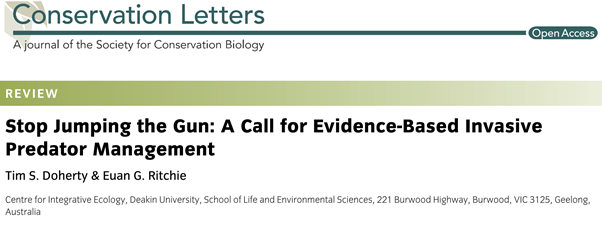1/16 We’ve got a weekend #rewilding paper for you! In this paper, @TimDoherty_ and @EuanRitchie1 discussed the complexities and issues with managing non-native predators through the use of lethal control methods
2/16 Around the world, non-native predator populations are lethally controlled through shooting, trapping or poison baiting and is commonplace in conservation policy
3/16 However, the authors highlight practical, ecological, and ethical concerns with lethal control. While it is primarily justified through benefitting biodiversity, there is little focus on the efficacy of the the approach
4/16 The authors note that effective predator control research is currently limited to closed systems (islands or fenced reserves) and that more work is required on prey coexistence with non-native predators in open systems (mainland)
5/16 The authors highlight four issues that compromise results of lethal control, followed by four alternative suggestions:
6/16 Issue 1: Cascading effects. Predator removal can release subordinate predator populations. In New Zealand, rats increased after possum removal and mice increased following rat removal. Killing larger predators can also influence large herbivores and vegetation structure.
7/16 Issue 2: Disrupting social systems. Culling programs can disrupt social systems and alter population dynamics through the removal of dominant individuals. In Australia, this is seen with dingoes on livestock predation and in the UK with badgers on TB transmission
8/16 Issue 3: Compensatory immigration. Given high costs, lethal control typically only occurs in subsets of a landscape. Due to high mobility, dominant individuals could move out of areas to avoid such culls making effects negligible
9/16 Issue 4: Ethical considerations. Culling programs are usually justified by prioritizing species conservation over the value of individuals. Such logic is challenged if there is no evidence that culls have a positive impact on at the species-level
10/16 Alternative 1: Top-predator conservation/reintroduction to regulate herbivores and mesopredator populations. Requires protective legislation, supportive public opinions, and non-lethal tools. However, more research is required on apex predators effects across ecosystems.
11/16 Alternative 2: Maintain habitat complexity and refuges. Non-native predator impacts are enhanced by anthropogenic habitat modifications. Fire and grazing experiments show conserving habitat refuges can boost native mammal populations even without lethal control of predators
12/16 Alternative 3: Exclusion fencing. Although expensive, predator-free reserves could boost native species populations that are threatened by even low levels of predation
13/16 Alternative 4: Acknowledging intra-specific variation in personality traits. In-situ encounters could naturally select for individual prey with appropriate defensive traits. Profiling ‘problem’ predators may also help targetted lethal control rather than blanket approaches
14/16 The aim of management should be to limit impacts of non-native predators on ecosystems, rather than the population size per se. Limiting impacts can involve a number of alternative methods to lethal control and the authors recommend multiple methods should be utilized
15/16 Finally, all conservation decisions should be evidence based. As such, we also need to acknowledge the complexities of socio-ecological systems and that there is unlikely to be a silver bullet solution across different environmental contexts
16/16 The full paper can be found here: https://conbio.onlinelibrary.wiley.com/doi/full/10.1111/conl.12251

 Read on Twitter
Read on Twitter


